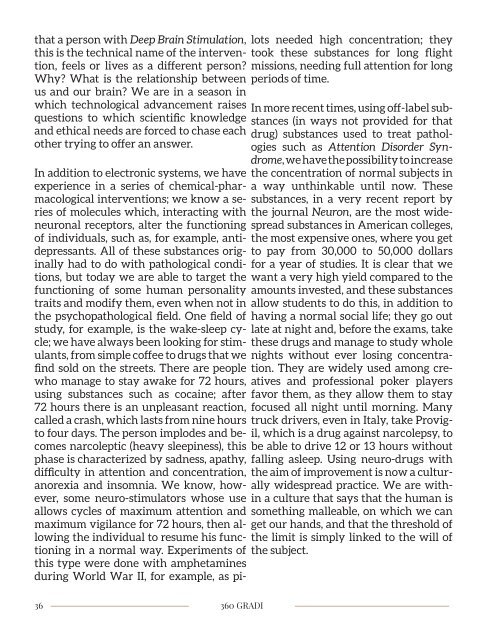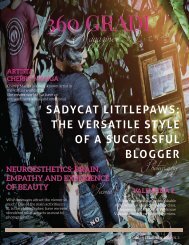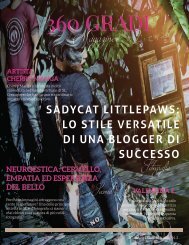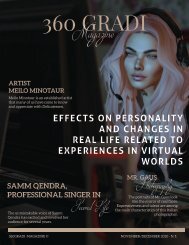360 GRADI MAGAZINE // MAY-JUNE 2021
360 GRADI Magazine is the trendy, elegant, refined, and sophisticated publishing about Second Life (the virtual world by Linden Lab). Out every two months.
360 GRADI Magazine is the trendy, elegant, refined, and sophisticated publishing about Second Life (the virtual world by Linden Lab).
Out every two months.
Create successful ePaper yourself
Turn your PDF publications into a flip-book with our unique Google optimized e-Paper software.
that a person with Deep Brain Stimulation,<br />
this is the technical name of the intervention,<br />
feels or lives as a different person?<br />
Why? What is the relationship between<br />
us and our brain? We are in a season in<br />
which technological advancement raises<br />
questions to which scientific knowledge<br />
and ethical needs are forced to chase each<br />
other trying to offer an answer.<br />
In addition to electronic systems, we have<br />
experience in a series of chemical-pharmacological<br />
interventions; we know a series<br />
of molecules which, interacting with<br />
neuronal receptors, alter the functioning<br />
of individuals, such as, for example, antidepressants.<br />
All of these substances originally<br />
had to do with pathological conditions,<br />
but today we are able to target the<br />
functioning of some human personality<br />
traits and modify them, even when not in<br />
the psychopathological field. One field of<br />
study, for example, is the wake-sleep cycle;<br />
we have always been looking for stimulants,<br />
from simple coffee to drugs that we<br />
find sold on the streets. There are people<br />
who manage to stay awake for 72 hours,<br />
using substances such as cocaine; after<br />
72 hours there is an unpleasant reaction,<br />
called a crash, which lasts from nine hours<br />
to four days. The person implodes and becomes<br />
narcoleptic (heavy sleepiness), this<br />
phase is characterized by sadness, apathy,<br />
difficulty in attention and concentration,<br />
anorexia and insomnia. We know, however,<br />
some neuro-stimulators whose use<br />
allows cycles of maximum attention and<br />
maximum vigilance for 72 hours, then allowing<br />
the individual to resume his functioning<br />
in a normal way. Experiments of<br />
this type were done with amphetamines<br />
during World War II, for example, as pilots<br />
needed high concentration; they<br />
took these substances for long flight<br />
missions, needing full attention for long<br />
periods of time.<br />
In more recent times, using off-label substances<br />
(in ways not provided for that<br />
drug) substances used to treat pathologies<br />
such as Attention Disorder Syndrome,<br />
we have the possibility to increase<br />
the concentration of normal subjects in<br />
a way unthinkable until now. These<br />
substances, in a very recent report by<br />
the journal Neuron, are the most widespread<br />
substances in American colleges,<br />
the most expensive ones, where you get<br />
to pay from 30,000 to 50,000 dollars<br />
for a year of studies. It is clear that we<br />
want a very high yield compared to the<br />
amounts invested, and these substances<br />
allow students to do this, in addition to<br />
having a normal social life; they go out<br />
late at night and, before the exams, take<br />
these drugs and manage to study whole<br />
nights without ever losing concentration.<br />
They are widely used among creatives<br />
and professional poker players<br />
favor them, as they allow them to stay<br />
focused all night until morning. Many<br />
truck drivers, even in Italy, take Provigil,<br />
which is a drug against narcolepsy, to<br />
be able to drive 12 or 13 hours without<br />
falling asleep. Using neuro-drugs with<br />
the aim of improvement is now a culturally<br />
widespread practice. We are within<br />
a culture that says that the human is<br />
something malleable, on which we can<br />
get our hands, and that the threshold of<br />
the limit is simply linked to the will of<br />
the subject.<br />
Pharmacologically, we are able to control<br />
what the memory process is; two drugs<br />
are being approved by the FDA (the US<br />
government body, which deals with the<br />
regulation of food and pharmaceutical<br />
products), whose initials are MEM-1213<br />
and MEM-10111. These molecules give a<br />
healthy subject the ability to permanently<br />
settle memories; imagine a college student<br />
who, after taking the pill, reads the book<br />
and never forgets it for a lifetime. Obviously,<br />
the risk is that this stay can also relate<br />
to negative experiences, such as the<br />
experience of violence; the person would<br />
be condemned to live that traumatic event<br />
every day with the same freshness and<br />
with the same immediacy as when it happened.<br />
We are sure that forgetting is not<br />
a defect of human nature, but something<br />
that we need to live life as we know it; understand<br />
how necessary it becomes to ask<br />
meaningful questions about the things we<br />
can do.<br />
We also know of the drugs that can be<br />
used with those who went to be a soldier<br />
on the front line and that allow, instead,<br />
the cancellation of sedimented memories.<br />
One general claimed that the United<br />
States spends about $ 3 million to train<br />
and equip a Marine who goes to the front.<br />
Thanks to the training and equipment he<br />
comes home alive from the battlefield, after<br />
two nights he kills his wife, son, dog,<br />
two neighbors and four passersby. This is<br />
because his brain has been under severe<br />
stress and he responds with a traumatic<br />
condition, which is called PTSD. He needs a<br />
substance for his brain that makes him immune<br />
to this danger; for this purpose, cannabinoid-based<br />
drugs are being developed<br />
which, associated with psychotherapy, allow<br />
the removal of selective memories.<br />
What is at the base is the very concept<br />
of malleability and improvement of the<br />
human person.<br />
The problem is represented by this ambiguity<br />
of technology, which is colored<br />
with different meanings, depending on<br />
its use, and the challenge is posed precisely<br />
at this level; the idea is to be able<br />
to arrive at what is called an augmented<br />
reality vision. This means putting layers<br />
of information between us and reality,<br />
in order to enrich the latter. This<br />
system is now in the public domain and<br />
the latest iPhone, in its operating system,<br />
has incorporated elements of augmented<br />
reality. NBIC (Nanotechnology,<br />
Biotechnology, Information technology<br />
and Cognitive science) conveys the idea<br />
that, thanks to nanotechnologies, we<br />
are now able to have machines that<br />
can interface with molecules, because<br />
they work more or less in the same dimension.<br />
If we, at the nanometer level,<br />
make these machines interact with a<br />
biological system, we can have an information<br />
exchange within a living body<br />
controlled by us, which can produce a<br />
cognitive response in the direction we<br />
want. The question that arises at this<br />
point is: can we do all we can do? All the<br />
arguments articulated on this theme<br />
are nothing more than a composition of<br />
a few key arguments, which are played<br />
with each other to obtain a yes or a no.<br />
The main argument concerns the fear<br />
of the uncertain and, in fact, responds<br />
to the idea that every time we put our<br />
hands on man, precisely because of the<br />
complexity, we do not necessarily get<br />
what we wanted to achieve, there is al-<br />
36 <strong>360</strong> <strong>GRADI</strong> <strong>360</strong> <strong>GRADI</strong><br />
37











